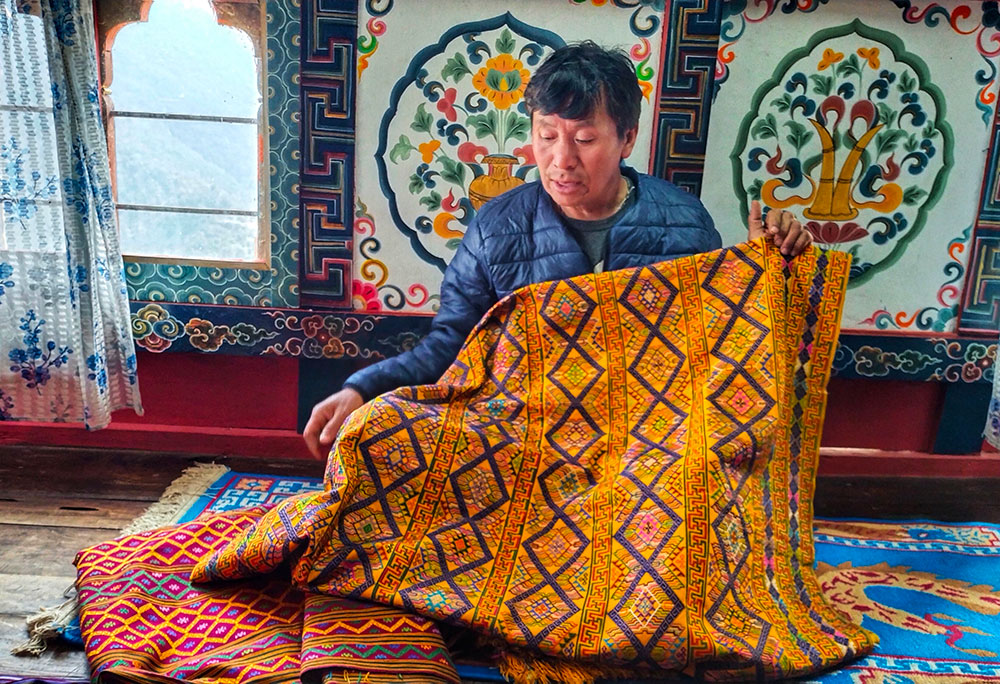Neten Dorji
Trashigang -“I started getting into the loom when my sister couldn’t complete weaving a bag for me as my new academic admission deadline approached,” Sonam recalls fondly. “By then, I began fiddling around with yarn and continued weaving whenever I had time or during vacations,” says Sonam Jamtsho.
Today, Sonam Jamstho stands as a unique figure in the hamlet of Kurchelo Village, Trashigang, as the sole male weaver in the community. His journey with the loom began at the tender age of 13, and over the span of 35 years, he has become a renowned artisan.
In the land of weaving and textiles, a man at the loom is not a common sight. However, the 54-year-old feels quite at home at the loom where he has woven thousands of kiras and ghos throughout his career.
Sonam, one of Bhutan’s few male weavers, is perhaps the most recognised. He ‘secretly picked up’ weaving by observation and has raised five children. He had quite a reputation for his weaving skills in the village.
He formally took up a full weaving career at the age of 20 after he couldn’t continue his studies due to financial constraints.
No one taught him the skills. Weaving skills came naturally to him; otherwise, skills are traditionally passed down by mothers and grandmothers. “It is a gift from above,” he says.
Sonam Jamtsho mostly weaved for Khaling Weaving Centre. He also weaves when there is an order from a customer. He gets orders from as far as Thimphu, Dewathang, Mongar and Trashigang.
Reflecting on the past, Sonam recalls the challenges he faced while living inside a hut. Traveling by foot to buy yarn, he would weave day and night, striving to provide education for his five children. He began to earn Nu 210 for weaving a gho and kira in 1994.
Sonam’s primary interests lie in patterned kiras and ghos, and found designing them artistically satisfying as there is no limit to the range and variety of designs.
“Imagination is the only limit,” says Sonam, drawing design inspiration from nature, such as flowers, and imported attires and fabrics, while incorporating traditional designs. “Patterned clothes are in high demand in the market today. Everyone wants to wear gho and kira.”
He also weaved two Kishutharas, which are extremely intricate patterned silk textiles.
Today, his focus has shifted to weaving belts (Kayra). Despite societal expectations, Sonam doesn’t feel ostracised as a male weaver. At least he hasn’t encountered any resentment. “People appreciate my work, and I take pride in what I do.”
Through weaving, Sonam and his family were able to purchase 50 decimals of land, build houses, and start a grocery business in Kurchelo village.
His passion is also shared by his wife, Choki Lhamo. She has also learned how to create various patterns. “He knows more about weaving than I do,” says Choki Lhamo, noting his expertise. She mentions his speed, saying, “When he finishes two kiras, I can only finish one. So, I normally stick to household chores.”
Sonam, who cannot envision making a living any other way, is determined to do whatever he can to preserve Bhutan’s textile tradition. “It is completely a unique art,” he emphasises. “Perhaps I am too old to weave, but I believe there is no equal to our weaving and textiles. Our kiras and ghos are among the finest garments in the world. I want to weave until the day I die.”


